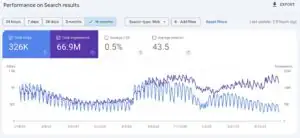Key steps to optimise global enterprise sites for multilingual & multi-market search
1. Define a dual strategy: SEO + GEO
Large multi-national corporations (MNCs) often operate across different countries with multiple languages, regulatory requirements, and product lines. They need a global framework that defines core SEO principles but allows local teams to customise content for each market.
- Enterprise marketing teams must plan for both international SEO and GEO, implementing a global framework but with content localisation.
- If resources are constrained, prioritise markets based on demand, revenue, and competition.
- Language vs. country: For example, decide if Spanish content should differ for Spain and Latin American countries.
- AI-first mindset: Identify where your content can appear in Google AI Overviews or ChatGPT answers – typically by focusing on informational, high-authority content.
- GEO focus: create structured, authoritative content designed to be cited in AI-generated responses (Google AI Overviews, ChatGPT, Copilot, etc.).
For example, a multinational consumer electronics company may face restrictions on the type of smart home products they can sell in the EU and Asia. The website would need to be optimised with region-specific content that reflects local regulations, electrical standards, and even prevents certain products from being visible in restricted markets.
2. Structure your website for international search
How you structure your site affects both SEO and GEO. At enterprises with global scale, decisions on structure can impact the ease with which local teams can create, optimise, and promote content. At the highest web domain level, there are three common options:
- Subdomains (fr.example.com): easier to manage, less local authority.
- Subdirectories (example.com/fr/): scalable, authority is consolidated.
- ccTLDs (example.fr): strong local trust, but harder to manage.
Most enterprises benefit from subdirectories + hreflang, ensuring consistency across markets. The impact of digital PR activities is much greater in this configuration, as links earned boost the entire domain’s authority. For GEO, this structure still allows crawlers to easily understand the context of multilingual versions of the site, so long as hreflang is used.
3. Implement hreflang correctly
Hreflang is an HTML attribute used in international SEO to signal which language and regional version of a page to show. Done right, it prevents duplicate content issues and can improve your international user experience.
Best practices:
- Correct ISO codes (en-gb, es-mx).
- Reciprocal referencing across pages.
- Use XML sitemaps or on-page tags consistently.
Large enterprise sites with English content that’s duplicated across multiple markets (e.g. USA, Canada, UK, India) need to pay special attention to this. At AccuraCast, we’ve also found it’s more important to invest in regional link building to prevent Google from over-riding hreflang settings and selecting other canonical versions of pages in this situation.
For AI Overviews, correctly set hreflang also helps Google’s systems select the most relevant version to surface globally.
4. Localise content beyond translation
 As we mention in several other articles, translation it’s not the same as localisation. To truly localise your brand, content, and products / services you should:
As we mention in several other articles, translation it’s not the same as localisation. To truly localise your brand, content, and products / services you should:
- Do keyword research in each market, don’t just translate your content.
- Adapt tone, imagery, and CTAs to cultural expectations.
- Be mindful of compliance and context in each market.
As an example, when a global automotive brand localises content, they need to reflect local driving laws, fuel standards, and popular vehicle configurations in each market.
Enterprises with overly centralised marketing teams often face challenges when localising content. Recognising the importance of local customs and lingo can be the difference between customers selecting your brand and a local competitor.
5. Optimise content for generative search engines
Generative AI search experiences are changing how enterprises appear online. Traditional SEO alone is no longer enough.
Key GEO tactics:
- Answer-focused content: Write in Q&A formats, FAQs, how-tos, and summaries that AI engines can easily lift.
- Structured data: Implement schema to make your content machine-readable.
- Authority building: Highlight author expertise, cite credible sources, and use E-E-A-T principles (Experience, Expertise, Authoritativeness, Trustworthiness) to establish your content’s worthiness.
- Content depth: Generative engines favour comprehensive, well-structured information.
6. Adapt tactics for AI Overviews & generative AI search
 The rise of Google’s AI Overviews and other generative engines is already reshaping how users discover and consume information. Unlike traditional search results pages, where multiple links compete for clicks, generative search condenses answers into a single, AI-generated summary. This is creating what SEO professionals are calling the “crocodile mouth effect” or the “Great Decoupling“ – a widening gap between the total number of clicks and total number of impressions.
The rise of Google’s AI Overviews and other generative engines is already reshaping how users discover and consume information. Unlike traditional search results pages, where multiple links compete for clicks, generative search condenses answers into a single, AI-generated summary. This is creating what SEO professionals are calling the “crocodile mouth effect” or the “Great Decoupling“ – a widening gap between the total number of clicks and total number of impressions.
AI search optimisation tactics:
- Optimise beyond keywords: Think beyond short queries. Users today ask questions, often in great detail. Content should anticipate user intent with direct, helpful, and well-structured answers that AI can easily summarise.
- Adapt brand signals: As mentioned in our article linked above, the fall in organic search traffic isn’t necessarily a bad thing. But marketers need to adapt performance measurement to the new reality. Mentions, reviews, and authoritative third-party references matter more in AI-driven search rankings.
- Experiment with AI-native advertising: we’re entering a world where AI-native ad formats (sponsored answers, conversational placements) will become critical. Brands that learn to blend organic GEO efforts with paid opportunities in generative search will stay ahead of the curve.
7. Strengthen technical SEO across markets
Technical SEO ensures your site performs reliably across all regions and devices. Large enterprise web teams manage complex infrastructure, multiple domains, and high traffic volumes. Technical SEO considerations like crawl budget, crawl efficiency, availability, speed, and indexability become important considerations.
- Crawl discovery: Large enterprise sites are more likely to struggle with having a higher percentage of their content indexed by Google and Bing. Maximising discoverability is half the battle for enterprise websites.
- Speed: Use of CDNs can reduce latency globally and also reduce the direct server load during peak periods.
- Implement proper redirects: Use 301 redirects for moved or outdated pages to preserve link equity and maintain a smooth user experience across regions. This also helps with crawl efficiency.
- Canonical tags & hreflang: Avoid content duplication across market versions, and preserve crawl budget for only canonical (primary) versions of your pages.
These fundamentals ensure crawlability and indexability across multiple markets and platforms.
8. Align paid and organic search internationally
Combining SEO and paid advertising campaigns amplifies visibility across markets. Paid search can inform organic strategies while SEO ensures landing pages perform for both humans and AI engines.
- SEO and PPC should reinforce each other.
- Use PPC to test market-specific keywords.
- Apply learnings to long-term SEO strategies.
- Ensure landing pages used in paid campaigns are also LLM-friendly, semantically structured, and localised.
Enterprises can leverage cross-market data at scale. Paid campaigns test keywords, messaging, and AI performance across regions, feeding insights back to organic SEO strategy.
At AccuraCast, we recommend integrating SEO, paid media, and GEO strategies so enterprise clients dominate across both organic and paid search results.
www.accuracast.com (Article Sourced Website)
#Optimise #Global #Enterprise #Sites #Multilingual #MultiMarket #Search
